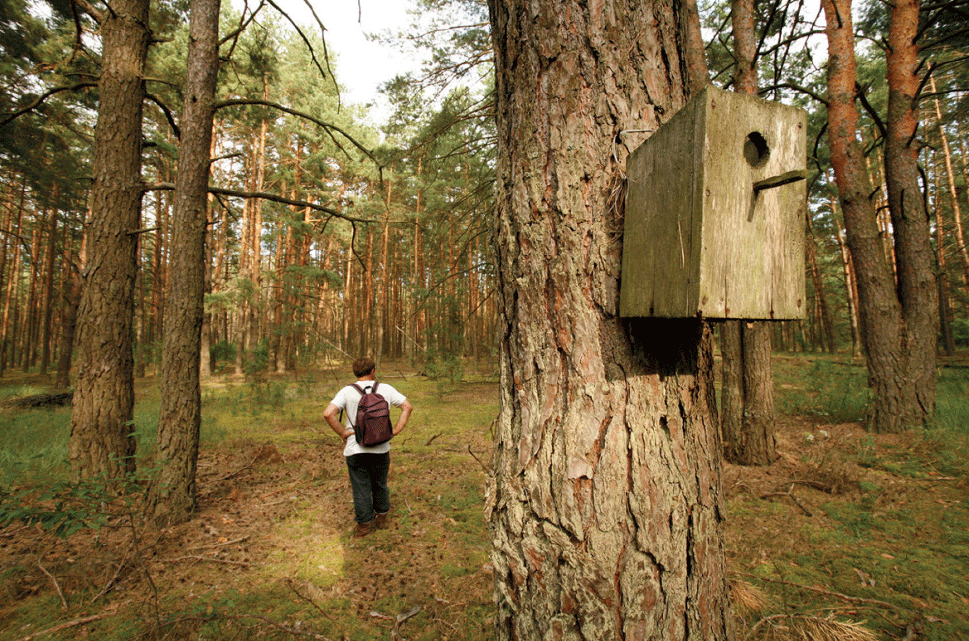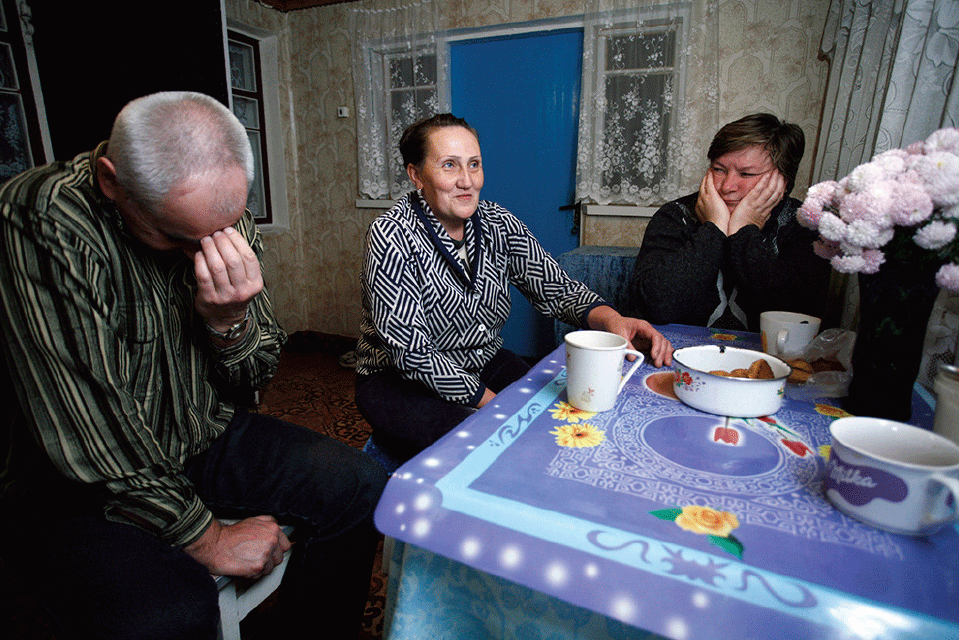Beyond the Headlines
Air Date: Week of April 25, 2014

Monitoring the radiation levels at Chernobyl (photo: Michael Forester Rothbart)
In this week’s trip beyond the headlines Peter Dykstra tells host Steve Curwood learn about tourism in Chernobyl and commemorates the publication of a famous Newsweek article on global cooling that has inspired climate change deniers for decades.
Transcript
CURWOOD: Let’s come up from under the waves now, and head to Conyers, Georgia, for our weekly trip beyond the headlines with Peter Dykstra. He's the publisher of Environmental Health News -- EHN.org and DailyClimate.org and joins us on the line. Hi there, Peter.
DYKSTRA: Hi, Steve. I’ve got a tourism story for you like no other. It’s from the Newsweek writer named Alexander Nazaryan. He took a little excursion recently, on the company dime, to a fast-growing tourist destination in a country where you wouldn’t expect to see growing tourism.

The empty forest around Chernobyl (photo: Michael Forester Rothbart)
CURWOOD: And that country would be?
DYKSTRA: The Ukraine, our most recent global flashpoint, the place where the old Cold War may start to be re-enacted, but one of the Ukraine’s most famous gifts from Russia is starting to draw a crowd, and that gift is none other than the Vladimir Ilyich Lenin Atomic Power Station, better known to the world as Chernobyl.
CURWOOD: I suppose it is a “hot” destination...

Many people advocate for building solar arrays on top of Superfund sites (photo: bigstockphoto.com)
DYKSTRA: Well, yeah. The Ukranian government...it’s not entirely off limits...there’s tourism around, not in, the Chernobyl plant. They started offering limited access to Chernobyl about a decade ago, despite the fact that there are serious radiation risks, and that those risks will persist long after we’re gone. In 2004, they drew about 800 tourists, but this year, one Kiev-based travel outfit says they’ll take about 12,000 people to the ruins.
CURWOOD: It still sounds a little crazy.
DYKSTRA: Yeah, I don’t disagree, but this is a great story. Alexander Nazaryan, the writer, describes walking around Pripyat, that’s the ghost town that used to have 49,000 people in it, most of them involved in running Chernobyl. Some places are off limits, you always have to carry a dosimeter there, and obviously, you don’t stick around too long, and the guest cottage where they put you up advises you to remove your radioactive shoes before going inside.
CURWOOD: So with all the turmoil and anguish in the Ukraine, one of the things that’s thriving is the ghost town at Chernobyl.
DYKSTRA: Yeah, and whatever you think of Vladimir Putin, don’t ever say that Russia has never given the Ukraine anything. Next story?
CURWOOD: Sure.

A family in Chernobyl (photo: Michael Forester Rothbart)
DYKSTRA: The Reilly Tar and Chemical Company, on the southwest side of Indianapolis, they refined coal tar and treated wood products for decades, they closed down in 1972 and left a big enough mess that it became a 120-acre Superfund site. It was an eyesore when it closed, a patch of land whose only use was a storage lot for truck trailers, of course, that didn’t make it any less of an eyesore.
CURWOOD: And I take it we had some kind of re-birth where the Princess kisses the Frog?
DYKSTRA: Well, not quite, because science tells us that neither Princesses nor frogs tend to hang out or thrive at Superfund sites contaminated with things like creosote, benzene, and pyridine. But what did happen is that the company that inherited the abandoned property stuck up a partnership with a solar company, that brought in the EPA, local government and the local utility to take about a third of the site and turn it into a solar farm: 43 acres of solar panels. EPA’s been involved in converting several Superfund sites into solar farms, this is the biggest one yet, and they have plans to triple the size of this one and cover most of the former Superfund site.
CURWOOD: So unlike Chernobyl, it looks like a happy ending.
DYKSTRA: Well, in fairness, you may eventually have a happy ending at Chernobyl, but we’ll have to wait thousands of radioactively miserable years to find out.
CURWOOD: So, tell me, Peter, what’s on the history calendar this week?
DYKSTRA: Well, Steve, when you deal with science on anything, generally you don’t start with a 38-year-old magazine piece, right?
CURWOOD: Yeah, that’s generally not how science works, and, for that matter, that’s not how journalism usually works either.
DYKSTRA: Well it’s time to wish a happy 38th birthday to that infamous Newsweek Magazine story on global cooling. Time Magazine did one back then, too, and back in the 1970s there was some speculation that we were entering a cooling period. Even big-brained thinkers like Buckminster Fuller took it seriously.
CURWOOD: Yeah, but I don’t think most of the science community took it all that seriously.
DYKSTRA: Correct, and this is 38 years ago...we were still in Vietnam, I was still in high school, and yet this is now still a major talking point for climate science deniers. Back in January of this year, one of our contributors, Doug Struck, went and tracked down the guy who did that Newsweek story 38 years ago. The reporter gave us a very reporter-like answer and said he stands by the story to this day, based on what he knew then, but he also admitted to being astounded that a 38-year-old magazine piece about global cooling is still being talked about.
CURWOOD: You mean like you and I are, now, thirty-eight years later?
DYKSTRA: OK. Yeah. Busted. So maybe I shouldn’t have brought it up.
CURWOOD: Peter Dykstra is Publisher of Environmental Health News, that’s EHN.org and the DailyClimate.org. Thanks so much, Peter.
DYKSTRA: Thanks a lot, Steve, we’ll talk to you soon.
CURWOOD: And there’s more on these stories on our website LOE.org.
Links
Living on Earth’s Bruce Gellerman documentary about his visit to Chernobyl in 1996.
Read about the famous Newsweek global cooling article on the Daily Climate
Living on Earth wants to hear from you!
Living on Earth
62 Calef Highway, Suite 212
Lee, NH 03861
Telephone: 617-287-4121
E-mail: comments@loe.org
Newsletter [Click here]
Donate to Living on Earth!
Living on Earth is an independent media program and relies entirely on contributions from listeners and institutions supporting public service. Please donate now to preserve an independent environmental voice.
NewsletterLiving on Earth offers a weekly delivery of the show's rundown to your mailbox. Sign up for our newsletter today!
 Sailors For The Sea: Be the change you want to sea.
Sailors For The Sea: Be the change you want to sea.
 The Grantham Foundation for the Protection of the Environment: Committed to protecting and improving the health of the global environment.
The Grantham Foundation for the Protection of the Environment: Committed to protecting and improving the health of the global environment.
 Contribute to Living on Earth and receive, as our gift to you, an archival print of one of Mark Seth Lender's extraordinary wildlife photographs. Follow the link to see Mark's current collection of photographs.
Contribute to Living on Earth and receive, as our gift to you, an archival print of one of Mark Seth Lender's extraordinary wildlife photographs. Follow the link to see Mark's current collection of photographs.
 Buy a signed copy of Mark Seth Lender's book Smeagull the Seagull & support Living on Earth
Buy a signed copy of Mark Seth Lender's book Smeagull the Seagull & support Living on Earth

